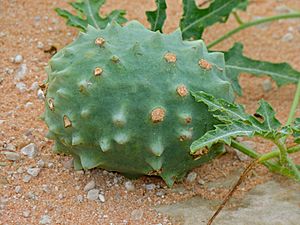Acanthosicyos naudinianus facts for kids
Quick facts for kids Acanthosicyos naudinianus |
|
|---|---|
 |
|
| Conservation status | |
| Scientific classification | |
| Genus: |
Acanthosicyos
|
| Species: |
naudinianus
|
| Synonyms | |
|
|
Acanthosicyos naudinianus, also known as the Gemsbok cucumber, is a perennial plant from Africa. This means it lives for more than two years. It is a type of melon plant. Both its fruits and seeds can be eaten.
Contents
About the Gemsbok Cucumber
The Gemsbok cucumber plant has leaves that look like a hand with five deep parts. These leaves grow in an alternating pattern along the stem. The plant's stem can grow quite long, up to 6 meters (about 20 feet).
Plant Features
The stems have special parts called tendrils. These tendrils help the plant climb. On the Gemsbok cucumber, these tendrils have changed into small, weak spines. The plant produces pretty yellow or white flowers.
Male and Female Plants
Interestingly, Gemsbok cucumber plants are dioecious. This means that some plants have only male flowers, and other plants have only female flowers. You need both a male and a female plant for fruits to grow!
The Fruit
The fruit of the Gemsbok cucumber is usually 4 to 12 centimeters (about 1.5 to 5 inches) long. It is covered in small spines. When the fruit is young, it is green. As it ripens, it turns a pale yellow color.
The fruit is edible, but it's important to eat it only when it's fully ripe. If you eat it before it's ripe, it can cause a strong, burning feeling in your mouth. The fruit itself is not poisonous. However, some parts of the plant, like its large, deep roots (which can be up to 1 meter long), are poisonous and should never be eaten.
Where It Grows
The Gemsbok cucumber is found in southern Africa. You can find it in countries like Namibia, Zambia, Zimbabwe, Botswana, Mozambique, and South Africa.
Its Home Environment
This plant naturally grows in woodlands, grassy areas with trees, and open grasslands. It really likes sandy soil. The Gemsbok cucumber does not do well in cold weather or frost. If you wanted to grow it, it would need a warm climate, similar to USDA zone 9.


